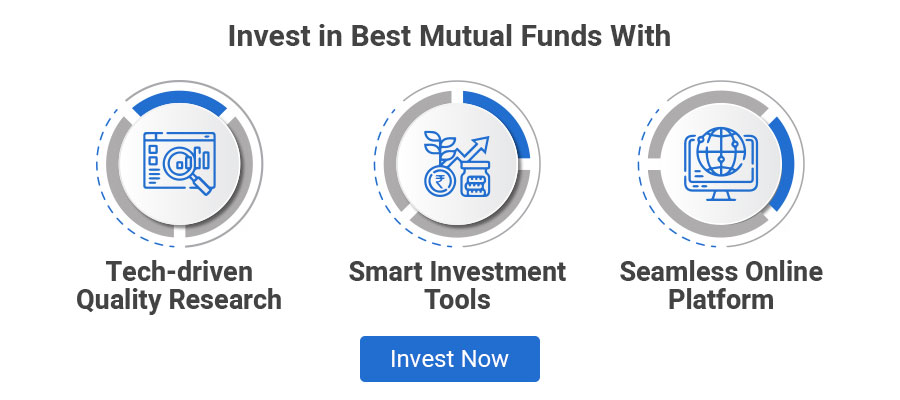In this Samco Investor Education Series, we will cover the topic of Debt Mutual Funds, one of the most popular investment options for medium-term investment among investors these days.
In this article, we will cover,- What are Debt Mutual Funds?
- Advantages and Disadvantages of investing in Debt Funds
- Returns and Risks
- When to Invest?
- Important things to look at before investing
- How to Invest and Redeem Debt Funds?
- Tax Implications and Strategies
What are Debt Mutual Funds?
Debt Funds are a type of mutual fund which invests in fixed income-generating securities. A debt fund may invest in Treasury Bills, Government Securities, short-term or long-term corporate bonds, money market instruments, floating-rate debt and other debt securities of different time horizons. The expense ratio on debt funds is usually lower, on average than equity funds because the overall management costs are lower.In simpler terms, investing in fixed income securities is like giving a loan to receive a fixed, pre-decided interest on the loan. There are various types of debt mutual funds such as Income Funds, Dynamic Bond Funds, Short-term and Ultra Short-term Debt Funds, Liquid Funds, Gilt Funds, Credit Opportunities Funds, and Fixed Maturity Plans. A brief description of different debt funds is given below.
- Gilt Funds invest in government securities. These are high-rated instruments and have a very low credit risk. This is because a government almost never defaults on its borrowings. This makes gilt funds preferable for risk-averse investors.
- Dynamic Bond Funds are funds where the manager constantly churns the portfolio composition according to the changing interest rate scenario. Dynamic bond funds have a fluctuating average maturity period because these funds take interest rate calls and invest in instruments of longer as well as shorter maturities.
- Income Funds can take a call on interest rates and invest in debt securities with completely different maturities, however generally, income funds invest in securities that have long maturities. This makes them a lot more stable than dynamic bond funds. The typical maturity of income funds is around 5-6 years.
- Overnight Funds invest in overnight securities and have a maturity period of 1 day.
- Short-term Debt Funds invest in debt & money market instruments such that the Macaulay duration of the portfolio is between 1 -3 years.
- Ultra Short-term Debt Funds invest in debt & money market instruments such that the Macaulay duration of the portfolio is between 3 months - 6 months.
- Fixed maturity plans (FMP) are closed-end debt funds. These funds invest in fixed income securities like corporate bonds and government securities; however, they have a lock-in period. All FMPs have a fixed time horizon for which your money will be locked-in. These horizons are often in months or years. Investments in FMPs are made only during the initial offer period. A FMP is a sort of a fixed deposit that may deliver superior, tax-efficient returns but it cannot be assured.
- Liquid funds invest in debt instruments with a maturity of fewer than ninety-one days. This makes them virtually safe. Liquid funds have seen negative returns very rarely. These funds are sensible alternatives to savings bank accounts as they give similar liquidity and better returns. Several mutual fund corporations provide instant redemption on liquid fund investments through special debit cards.
- Credit Opportunities Funds are comparatively newer debt funds. Unlike alternative debt funds, credit opportunities funds don’t invest as per the maturities of debt instruments. These funds attempt to earn higher returns by taking a call on credit risks. These funds attempt to hold lower-rated bonds that come with higher interest rates. Credit opportunities funds are comparatively risky debt funds.
Advantages and Disadvantages of investing in Debt Funds.
-Advantages
- Preservation of capital
- Provides a steady stream of income
- Returns are less volatile as compared to equity funds
- Freedom to withdraw money from the scheme as per requirement (for open-ended funds only)
- Low-Cost Structure as compared to equity funds
- Provides better returns than Fixed Deposits in most cases
- Indexation benefit in taxation
- Unlike FD where every year returns are taxed, returns on debt funds are taxed only on redemption or withdrawal.
-Disadvantages
- Debt funds are only useful for wealth preservation and not creation.
- During favorable market times, the return given by these are lower relatively
- Returns on investment are really low as compared to equity mutual funds
- They are not risk-free like Bank FDs
Returns and Risks
- Returns - Debt Mutual funds can deliver returns in the range of 7-8% in a year.
- Risks - Although Debt mutual funds are less volatile than equity markets, they are not risk-free. Risks involved are credit risk and interest risk. Credit risk means that the fund manager has invested in securities of a company which might default in repaying principal or interest, or both whereas interest risk means that the bond prices might fall due to rising interest rates.
When to invest in Debt Mutual funds?
- To balance a portfolio that contains equity investments
- When a regular stream of income is needed
- New investors can invest some portion in debt funds for making their portfolio less volatile.
Important things to look for before investing
- A fund manager, his investment strategies and past performance
- Credit ratings of the instruments invested in
- The expense ratio, entry, and exit load
- Minimum investment amount
- Outlook on the interest rate regime
How to Invest and Redeem Debt Funds?
Investors can buy debt funds in the following ways:- From Mutual fund distributors
- Directly from websites of Mutual funds
- From various online Direct mutual funds distributors
Debt funds usually do not levy an entry or exit load. But most of them do charge a CDSC (Contingent Deferred Sales Charge) which is a charge that reduces annually. It is a charge that is levied if the instrument/asset is sold within a specified time period in the form of an exit load. Most medium and long-term debt and gilt funds levy a CDSC of 0.5 percent if redemption happens within six months of investment. For short-term debt funds, the amount of the CDSC reduces to a maximum of thirty days and therefore the quantum of the load falls to 0.25 percent. Cash funds don't charge any load or CDSC for that matter. Typically in debt funds, the quantum of the CDSC and its period decreases as the investment horizon of the fund decreases.
Tax Implications and Strategies
Investments in debt mutual funds are taxed under the head of capital gains. If these investments are held for more than three years, then it will be taxed at 20% along with indexation benefit and 10% without indexation benefit; if held for less than 3 years, then it will be taxed at the marginal tax rate.
Thus, if you are in the highest tax bracket of 30%, then it is advisable to hold on to the investment for more than three years.
That covers in-depth information about Debt Mutual Funds which are a very popular investment option of recent times. For more useful articles on mutual funds, trading, investing and market knowledge, visit our Investor Education section.
 (Note: This content is for information purpose only. Avoid trading and investing based on the information given above. Before investing in stocks or mutual funds, please conduct proper due diligence).
(Note: This content is for information purpose only. Avoid trading and investing based on the information given above. Before investing in stocks or mutual funds, please conduct proper due diligence).




 Easy & quick
Easy & quick
Leave A Comment?